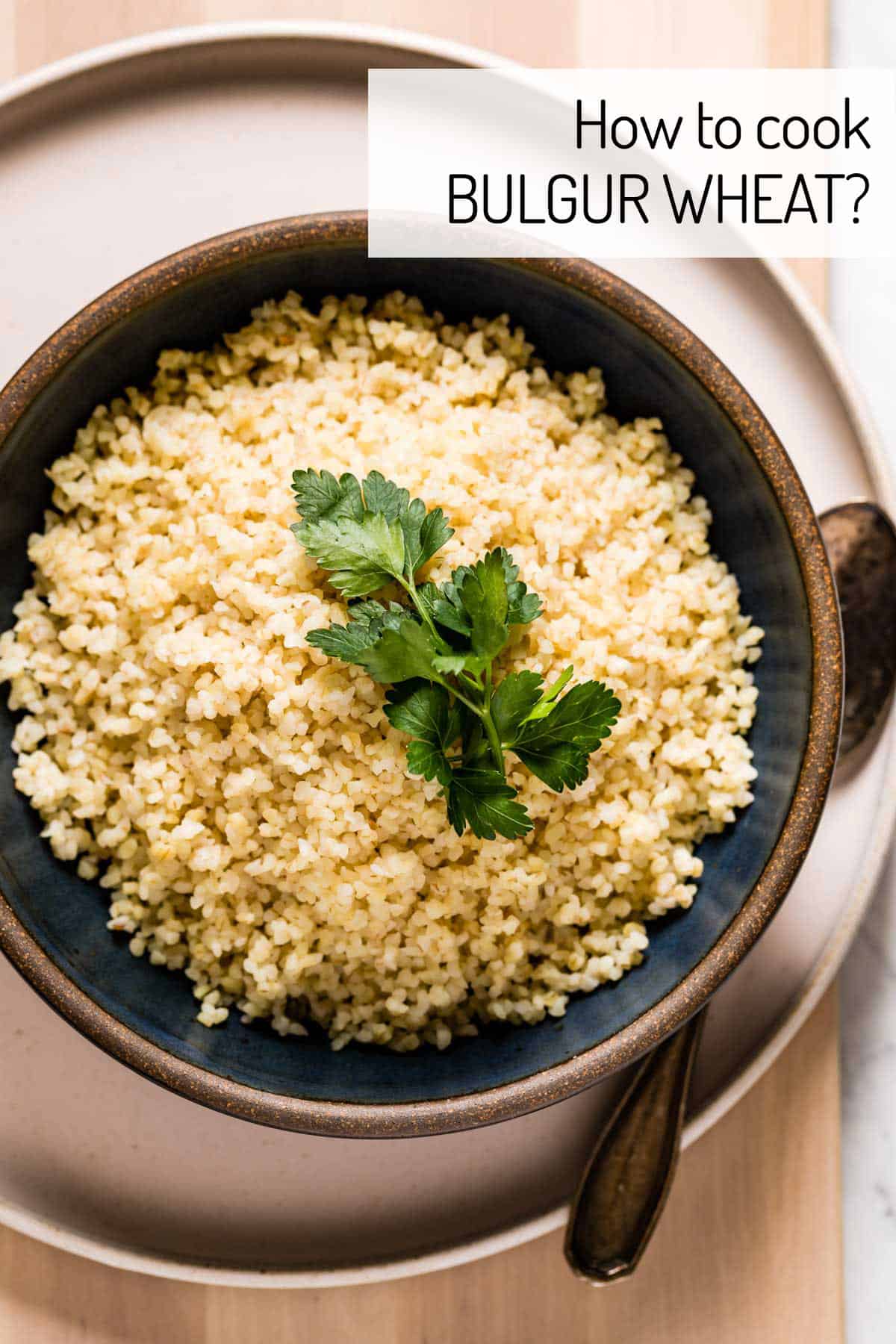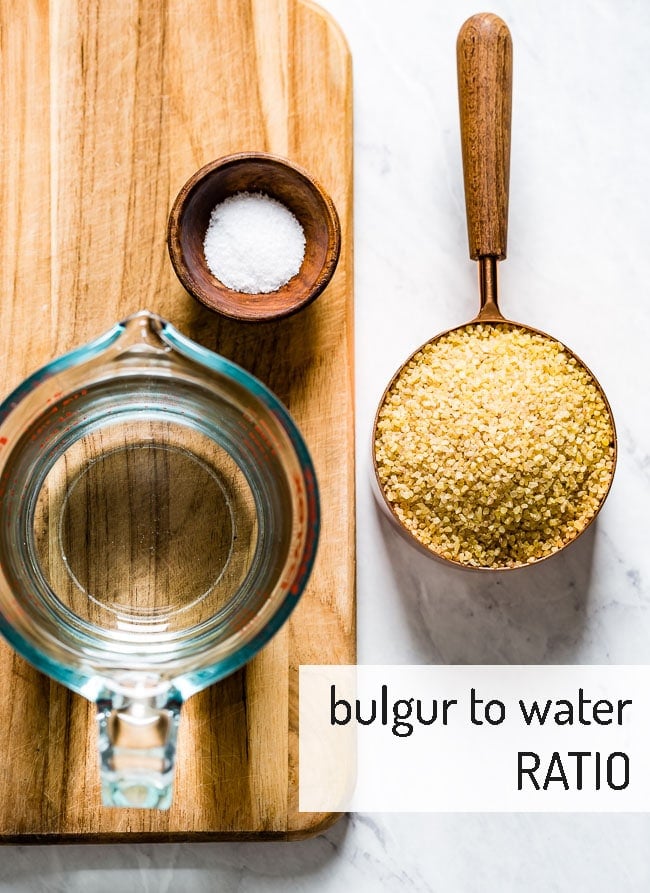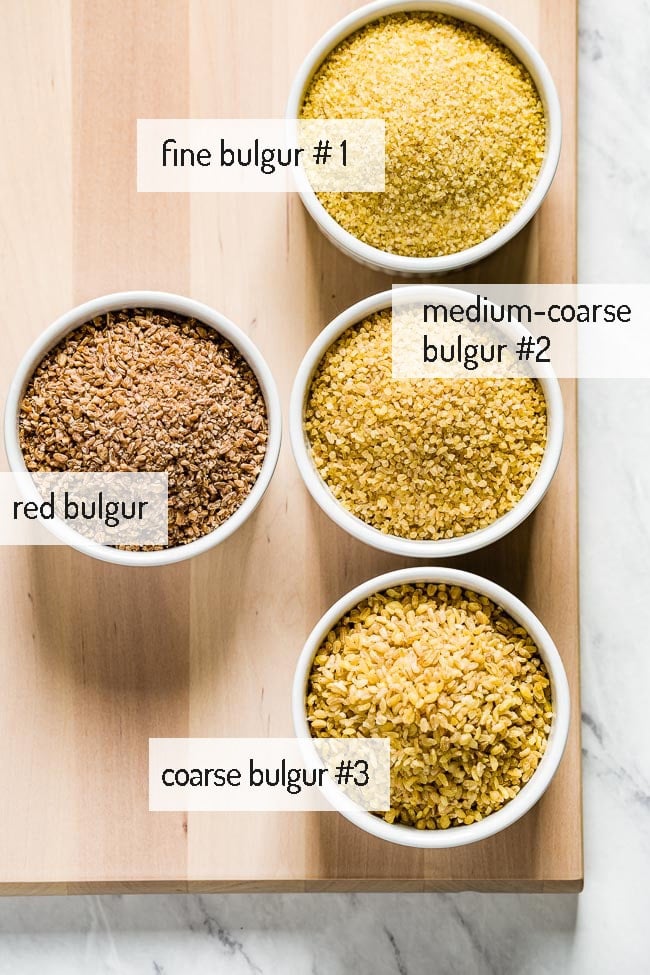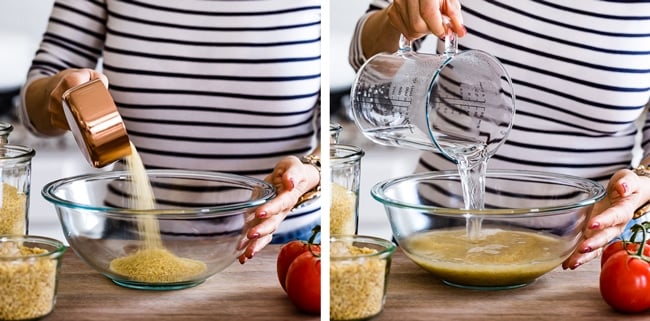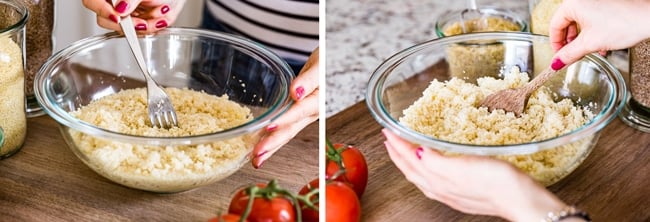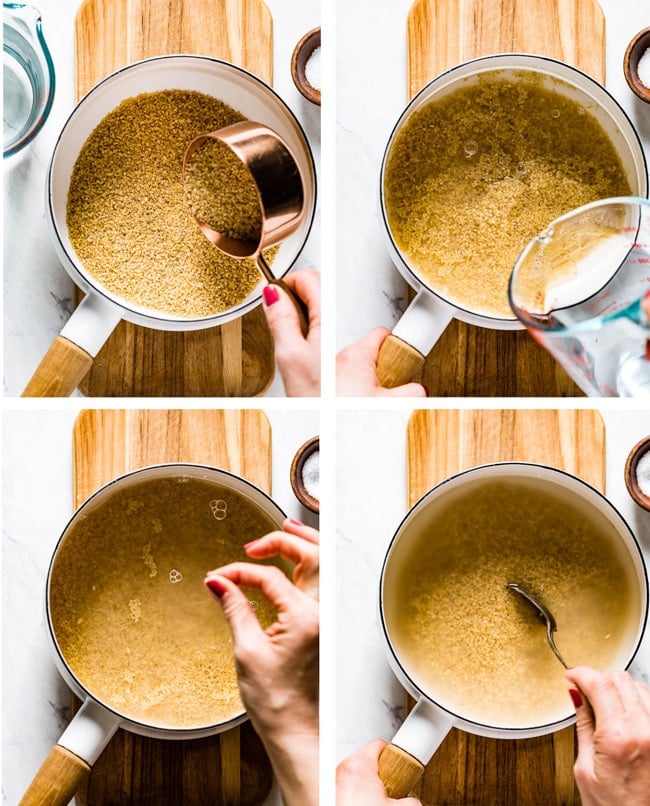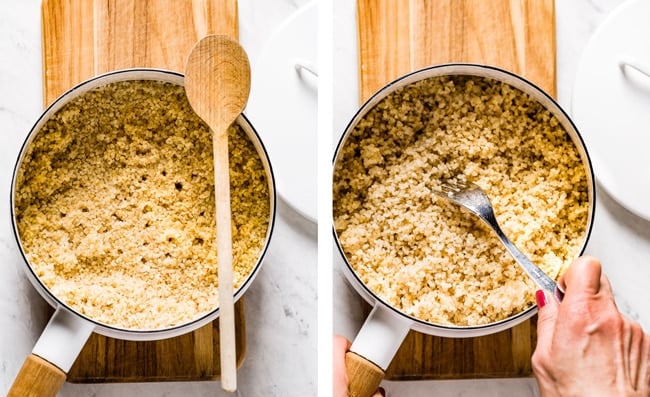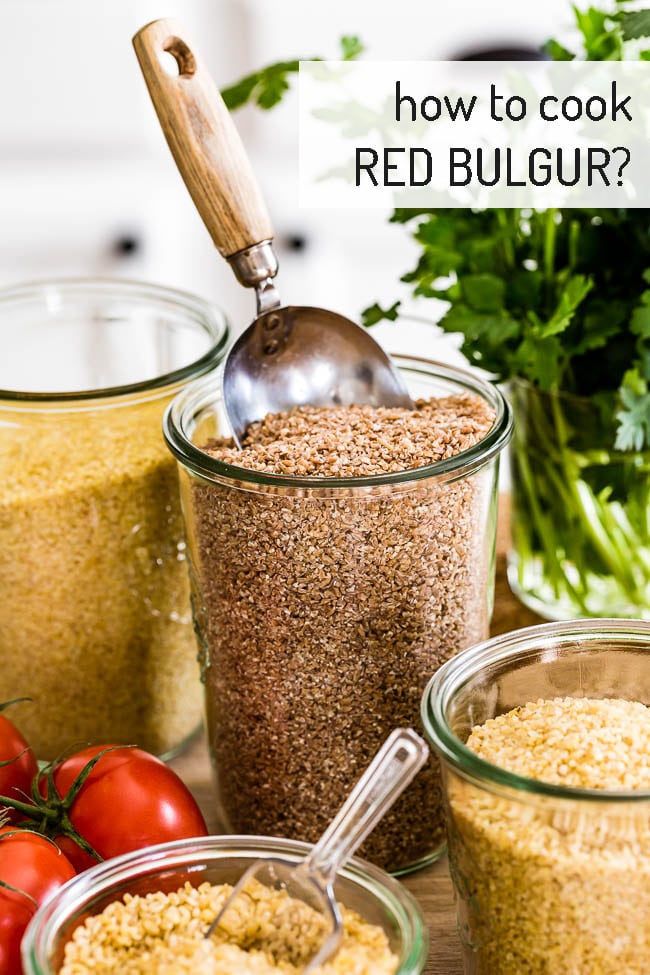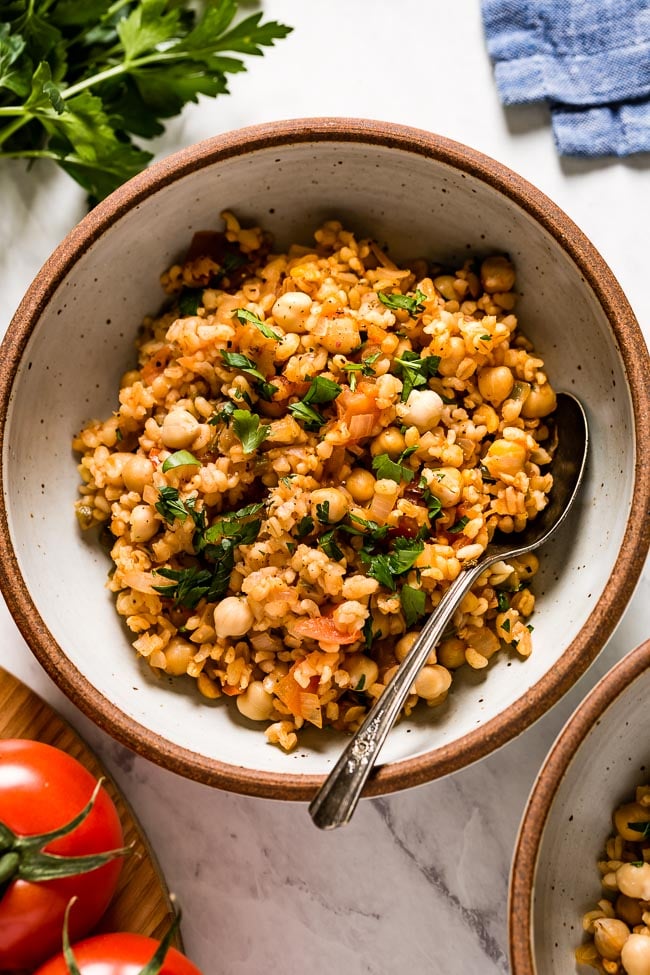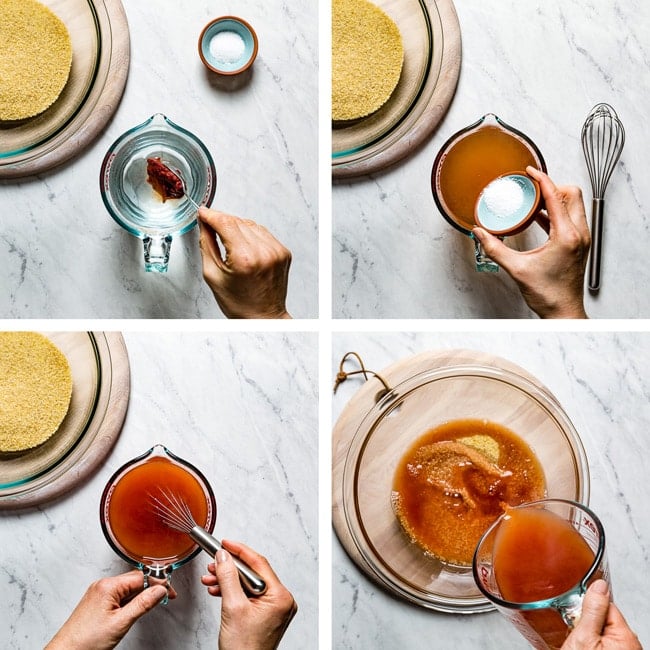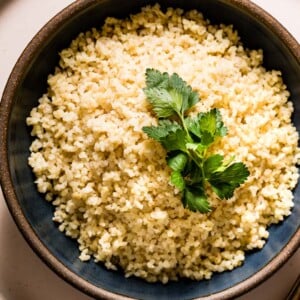In this post, we are going back to basics again and covering how to cook bulgur wheat. Below you will find details on how to make my basic bulgur recipe based on its type, along with instructions on cooking it on the stovetop, microwave, and rice cooker. If you are into Mediterranean & Middle Eastern cooking, be sure to check out all my Turkish recipes. I find that the ratio of 1 to 2, meaning 1 cup of bulgur to 2 cups of water, provides the best-cooked bulgur.
Do I Need To Wash It Before Cooking?
The answer to this question is that it is up to you.
Soaking for extra fine (or fine) bulgur – 1:2 – 1 cup bulgur wheat to 2 cups of boiling water/liquidStovetop – 1:2 – 1 cup bulgur wheat to 2 cups of water/liquidMicrowave – 1:2 – 1 cup bulgur wheat to 2 cups of water/liquidRice Cooker – 1:1 – 1 cup bulgur wheat to 1 cup of water/liquid
In terms of liquid, you can use a combination of water, chicken, or vegetable stock. Growing up, my mom would always wash bulgur before cooking it. When I say wash, I mean she would put it in a fine-mesh strainer and rinse it under cold water for 30-45 seconds before cooking it. Nowadays, if I am buying packaged bulgur, I do not rinse it before cooking. The only time I give it a quick rinse is if I am using the bulgur that I purchased from the bulk bin, as it is sold in open containers and can get dusty quickly. I do not feel any difference between rinsed and not rinsed bulgur after it is cooked in terms of taste. While the basic cooking method for any type of bulgur wheat can be done by placing it into a saucepan with water, I prefer cooking fine bulgur differently than other types of bulgur. Because it is so small in size, I do not see any point in boiling it. Instead, I soak it.
How To Cook Coarse Bulgur Wheat? The Stove Top Method:
Please know that the method of cooking I am listing below would work for medium-coarse, coarse grind, and extra-coarse bulgur. However, the cooking time might be slightly different depending on their size. You can find the timing according to the size of the bulgur below. To Cook Coarse Bulgur on the stovetop: One cup of dry bulgur yields approximately 4 cups of cooked bulgur.
Do I need to soak coarse bulgur?
You can if you want. And it will soften as it soaks. However, because it takes no longer than 15-20 minutes from start to finish to cook it, I think soaking coarse bulgur is not a necessary step.
Medium coarse bulgur #2 takes about 12 minutes to cookCoarse bulgur #3 takes between 12 to 14 minutesExtra coarse bulgur #4 takes about 15 minutes
The difference between regular yellow bulgur and red bulgur is that the yellow one is made from durum wheat (also known as pasta wheat) (source), and the red one is made from whole grain red wheat. Compared to durum wheat, red wheat is softer, and because of that, it cooks faster. Therefore, the cooking time for red bulgur is slightly shorter. The cooking process is no different, and it takes about 12-13 minutes for it to cook. In terms of nutrition and texture, red bulgur has a similar profile of vitamins and minerals and a chewy texture. As you can see in the image, in terms of size, it is close to medium coarse bulgur (#2), and it takes about the same amount of time to cook.
Microwave Cooking Instructions:
Similar to cooking quinoa in a microwave, the fastest way to cook bulgur is in the microwave. From start to finish, it takes about 13 minutes to cook. The method I explain below was tested with medium bulgur (#2) as it is the most widely available in the US. The cook time for other coarse types might be 1-3 minutes, depending on the size, and should be adjusted accordingly. One cup of uncooked coarse bulgur cooked in the microwave yields approximately 3 ⅓ cups of cooked bulgur. I tested the recipe below in my Aroma Rice Cooker (affiliate link), both with medium-coarse and coarse bulgur and the cooking time was not much different. One cup of uncooked bulgur cooked in a rice cooker yields approximately 3 ½ cups of cooked bulgur. Depending on the rice cooker you are using, there might be slight differences in settings. I tested this recipe using both the white rice and brown site settings, and the results in terms of cook time and taste were not different.
How To Cook It Turkish Style?
Even though I am sharing a detailed post on how to cook bulgur like rice, I never cooked it this way until I moved to the US. My Turkish mom always cooked it like rice, and we called it Bulgur Pilaf. It is what she served as a side dish with almost every meal. I wrote a whole detailed post on how to cook Turkish Bulgur Pilaf and use bulgur as a rice substitute, so be sure to check that out for more information on cooking it like rice. As it is with any other grain, while cooking fine bulgur, you can use any type of liquid you want to match your recipe’s flavor profile. For example, if you are cooking bulgur wheat for tabouli, you can mix in a few tablespoons of tomato paste and salt into the boiling water and soak it in that mixture. This way, your tabbouleh salad will have a nice tomato-ey flavor that carries throughout the whole dish. The same goes for soaking it in chicken or vegetable broth. The important thing here is to make sure that the liquid is boiling hot so that bulgur will cook quickly. You can soak it in non-boiling liquid, but it will take longer to soften/cook.
Should Bulgur Wheat Be Crunchy?
No, it should not. Instead, it should be soft and slightly chewy similar to brown rice.
What Is A Good Substitute?
My favorite substitute for bulgur is quinoa, especially if you are looking for a gluten-free alternative. While they taste quite different, I like that they offer a pretty similar texture when used in recipes. Therefore, recipes like the popular tabouli can be made with quinoa. Wheat berries, farro, and barley can also be a great substitute for bulgur. If you need more substitution ideas, be sure to check our article on Bulgur Substitutes.
Do you have a favorite bulgur brand you recommend?
I usually buy bulgur from a local Turkish supermarket. However, if I don’t have time to go there, I usually order it online. Below are brands that I use and recommend. Please know that these are affiliate links:
Duru – Fine Bulgur (#1) to make tabboulehReis – Coarse Bulgur (#3) to using in basic bulgur recipe.
Both of these brands offer various types of bulgur you can use in your cooking. I have used and continue to use and recommend them.
Recipe Ideas:
Now that you have some cooked bulgur, here are a few ways to use it in recipes:
